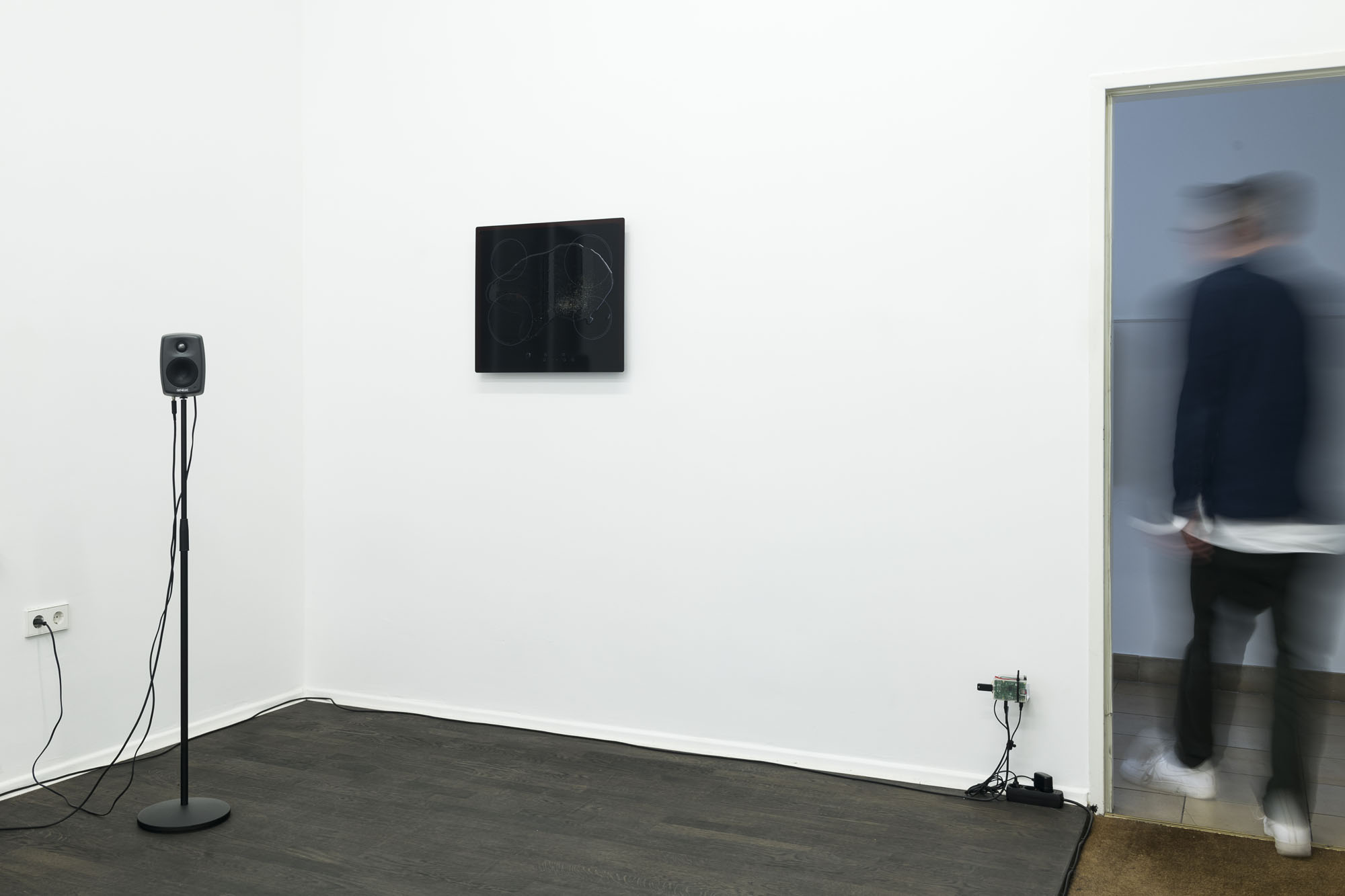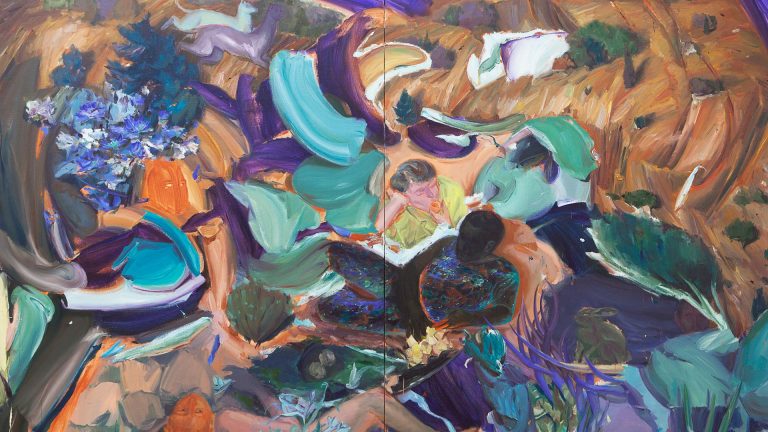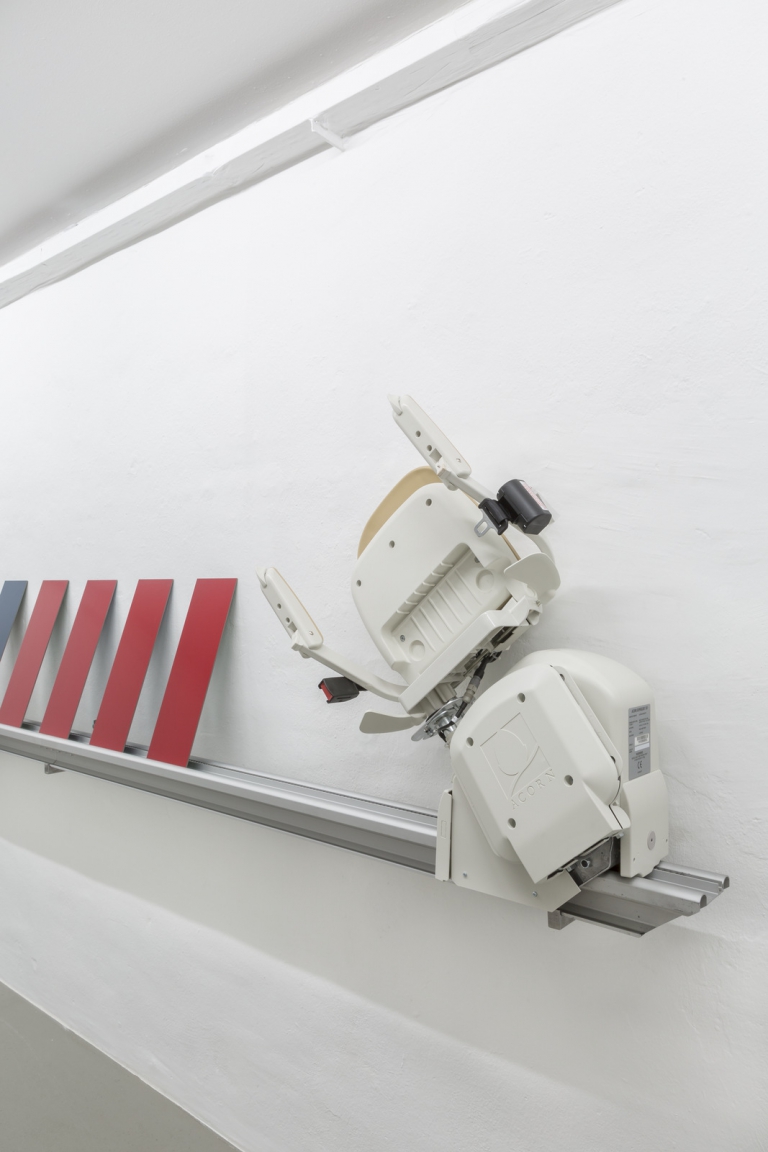Artist: Chris Evans
Exhibition title: Village Lawyer
Venue: Markus Lüttgen, Düsseldorf, Germany
Date: September 6 – October 26, 2019
Photography: all images copyright and courtesy of the artist and Markus Lüttgen, Düsseldorf
For Chris Evans’ latest exhibition at Markus Luettgen the Brussels based artist has worked with a local livestock farmer to produce a sound work and a herd of Charolais cattle to produce relief sculptures. Punctuating these works are a series of herb and spice paintings made on ceramic hobs.
Chris Evans’s exhibition, Village Lawyer, takes its title from a painting by Pieter Brueghel the Younger from 1621. In Breughel’s painting we see a busy and somewhat shambolic office scene. The room is full of local villagers bringing eggs and grains, in lieu of payment, to a lawyer who sits aloft behind a cluttered large table. In return the lawyer is ladening the villagers with piles of paperwork. The painting depicts a lop-sided transaction, and—through the villagers need of a lawyer—suggests an urgency for mediation between their needs and the state interfering in their interests.
Two sculptures from Evans’ series titled Cowlick feature transaction windows with Speak-Through holes, similar to those one might encounter in governmental administration offices for customs or passports. A starting point for Evans was to consider how he might augment imaginary transactional conversations with solid form.
A cowlick is the term used in English speaking countries to describe a wayward tuft of hair that grows in a different direction from that of the rest. A gentle perversion. For the relief sculptures, incorporated into the transaction windows, Evans worked with a farmer in rural Sussex, England, to cast licks made by a herd of Charolais cattle into jesmonite relief forms. The circles of speak-through holes in the glass are then positioned in relation to each form and together suggest landscapes in silhouette.
To accompany the Cowlick series, Evans commissioned the poet Holly Pester who wrote a sestina titled Marylyn Makes Futures that is presented as the press release to the exhibition. Particular to a sestina is that its form produces a repeating pattern which, if plotted as a diagram, would make a whirl pattern like a cowlick. When you hear or read a sestina, words reoccur in a sequence that also creates a sense of a wave or a swirl in the sound of it.
The English words ‘economy’ and ‘economics’ are inextricably linked to a sense of household through their etymology. They are derived from the Greek word οἰκονόμος (household management) a composite descending from οἶκος (home) and νέμω (manage).
The term Home Economics also points to a field of study which recalls the scene in Village Lawyer in that it concerns the relationship between individuals and the state. The class was integrated into the school curriculum in the late 1800s in the US with the original intention of teaching methods to structure home maintenance so that household chores would take up less time opening up more free time for other activities. However a bias towards a gendered notions of ‘homemaking’ skewered much of its initial focus on managing relationships between people, families and communities.
Evans’ series titled Home Economics are a lateral shift from a parallel series of works in which Evans visited the homes of visitors to an art museum (SALT Galata, Istanbul, 2018) and made paintings on their cooking hobs with the herbs and spices that they had in their kitchens. Taking the physical appearance of these works as an impulse to make sculptures, Evans produced a new series in which ceramic hobs are painted with herbs and spices such as poppy seeds, chilli powders, cumin, nigella, saffron and dill. Resinous slicks, resembling cooking oil spills, fix the herbs and spices in place and the hobs are hung vertically in the gallery.
A short musical composition titled ‘Jingle (‘Village Lawyer’, Markus Luettgen), 2019’ is the latest iteration of a series inspired by melodies used for interludes in American sitcoms, that connote scenic transition. The short musical compositions are activated by sensor upon entry and egress to cumulatively broadcast the arrival and departure of each visitor to the exhibition.
Evans first asks after a host’s economic stability. If the host gallery’s financial situation is stable, a local livestock farmer is asked to mimic a non-specific percussive phrase, if it is unstable, an accountant is asked to do the same. Evans chose these vocations with the thought that we each carry a personal inner soundtrack in our minds which, to some extent, is dependant on what we do in life. For the vocations of livestock farming and accountancy the sounds we anticipate are distinct and tangible and consequently we might be able to hear associations in the non-verbal noises elicited. A bass-line is then added and the Norwegian artist/composer Morten Norbye Halvorsen produces a composite from the recordings from which the jingle is made.

















